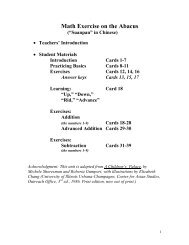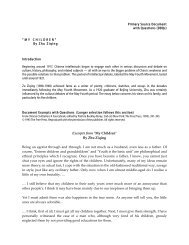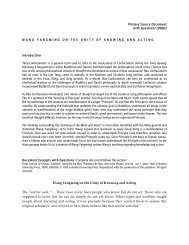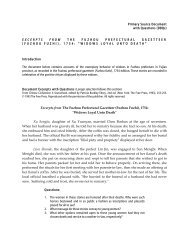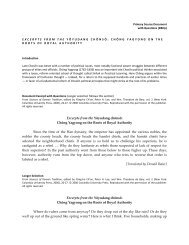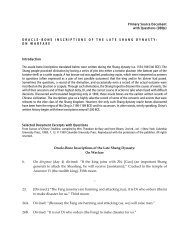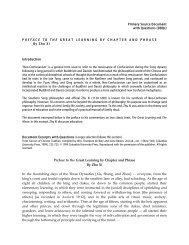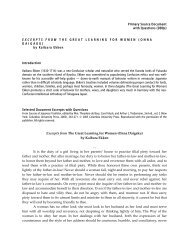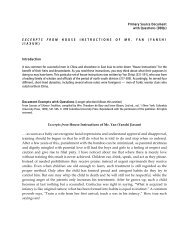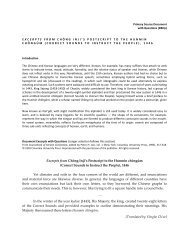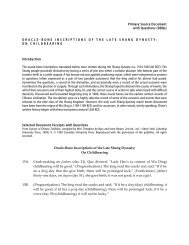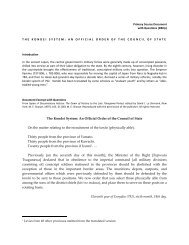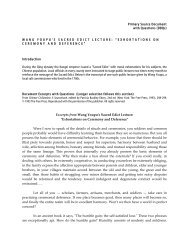REPORT OF THE INTERIM COMMITTEE ON THE MILITARY USE ...
REPORT OF THE INTERIM COMMITTEE ON THE MILITARY USE ...
REPORT OF THE INTERIM COMMITTEE ON THE MILITARY USE ...
Create successful ePaper yourself
Turn your PDF publications into a flip-book with our unique Google optimized e-Paper software.
Primary Source Document<br />
with Questions (DBQs)<br />
<strong>REPORT</strong> <strong>OF</strong> <strong>THE</strong> <strong>INTERIM</strong> <strong>COMMITTEE</strong> <strong>ON</strong> <strong>THE</strong> <strong>MILITARY</strong> <strong>USE</strong> <strong>OF</strong><br />
<strong>THE</strong> ATOMIC BOMB (MAY 1945)<br />
Introduction<br />
The dropping of the atomic bombs on Hiroshima (August 6, 1945) and Nagasaki (August 9, 1945) remains among the<br />
most controversial events in modern history. Historians have actively debated whether the bombings were<br />
necessary, what effect they had on bringing the war in the Pacific to an expeditious end, and what other options<br />
were available to the United States. These very same questions were also contentious at the time, as American<br />
policymakers struggled with how to use a phenomenally powerful new technology and what the long-term impact<br />
of atomic weaponry might be, not just on the Japanese, but on domestic politics, America’s international relations,<br />
and the budding Cold War with the Soviet Union. In retrospect, it is clear that the reasons for dropping the atomic<br />
bombs on Japan, just like the later impact of nuclear technology on world politics, were complex and intertwined<br />
with a variety of issues that went far beyond the simple goal of bringing World War II to a rapid close.<br />
In May 1945, Secretary of War Henry Stimson convened an Interim Committee on the Military use of the Atomic<br />
Bomb to make recommendations on the use of the new nuclear weapons (the first of which would only be tested in<br />
New Mexico in July of that year). The committee included General George C. Marshall, Army Chief of Staff; James F.<br />
Byrnes, an influential advisor to President Harry Truman; General Leslie Groves, the military administrator of the<br />
Manhattan Project, the secret operation that created the atomic bombs; Dr. Robert Oppenheimer, the scientific<br />
director of the Manhattan Project; and Dr. James B. Conant, president of Harvard University and chairman of the<br />
National Defense Research Committee.<br />
Document Excerpts with Questions<br />
From Major Problems in American Foreign Policy: Documents and Essays, by Thomas G. Paterson (D.C. Heath and Company, 1978).<br />
© 1978 D.C. Heath and Company. Reproduced with the permission of the publisher. All rights reserved.<br />
<br />
<br />
Report of the Interim Committee on <br />
the Military Use of the Atomic Bomb (May 1945) <br />
<br />
… <br />
The Secretary expressed the view, a view shared by General Marshall, that this project <br />
should not be considered simply in terms of military weapons, but as a new relationship of man <br />
to the universe. This discovery might be compared to the discoveries of the Copernican theory <br />
and of the laws of gravity, but far more important than these in its effect on the lives of men. <br />
While the advances in the field to date had been fostered by the needs of war, it was important <br />
to realize that the implications of the project went far beyond the needs of the present war. It <br />
must be controlled if possible to make it an assurance of future peace rather than a menace to <br />
civilization. <br />
…
Primary Source Document with Questions (DBQs) on<br />
<strong>REPORT</strong> <strong>OF</strong> <strong>THE</strong> <strong>INTERIM</strong> <strong>COMMITTEE</strong> <strong>ON</strong> <strong>THE</strong> <strong>MILITARY</strong> <strong>USE</strong> <strong>OF</strong> <strong>THE</strong> ATOMIC BOMB (MAY 1945)<br />
At this point General Marshall discussed at some length the story of charges and <br />
counter‐charges that have been typical of our relations with the Russians, pointing out that <br />
most of these allegations have proven unfounded. The seemingly uncooperative attitude of <br />
Russia in military matters stemmed from the necessity of maintaining security. He said that he <br />
had accepted this reason for their attitude in his dealings with the Russians and had acted <br />
accordingly. … With regard to this field he was inclined to favor the building up of a <br />
combination among like minded powers, thereby forcing Russia to fall in line by the very force <br />
of this coalition. General Marshall was certain that we need have no fear that the Russians, if <br />
they had knowledge of our project, would disclose this information to the Japanese. He raised <br />
the question whether it might be desirable to invite two prominent Russian scientists to witness <br />
the test. <br />
Mr. Byrnes expressed a fear that if information were given to the Russians, even in <br />
general terms, Stalin would ask to be brought into the partnership. He felt this to be particularly <br />
likely in view of our commitments and pledges of cooperation with the British. In this <br />
connection Dr. Bush pointed out that even the British do not have any of our blue prints on <br />
plants. Mr. Byrnes expressed the view, which was generally agreed to by all present, that the <br />
most desirable program would be to push ahead as fast as possible in production and research <br />
to make certain that we stay ahead and at the same time make every effort to better our political <br />
relations with Russia. <br />
It was pointed out that one atomic bomb on an arsenal would not be much different <br />
from the effect caused by any Air Corps strike of present dimensions. However, Dr. <br />
Oppenheimer stated that the visual effect of an atomic bombing would be tremendous. It would <br />
be accompanied by a brilliant luminescence which would rise to a height of 10,000 to 20,000 feet. <br />
The neutron effect of the explosion would be dangerous to life for a radius of at least two‐thirds <br />
of a mile. <br />
After much discussion concerning various types of targets and the effects to be <br />
produced, the Secretary expressed the conclusion, on which there was general agreement, that <br />
we could not give the Japanese any warning; that we could not concentrate on a civilian area; <br />
but that we should seek to make a profound psychological impression on as many of the <br />
inhabitants as possible. At the suggestion of Dr. Conant the Secretary agreed that the most <br />
desirable target would be a vital war plant employing a large number of workers and closely <br />
surrounded by workers’ houses. <br />
There was some discussion of the desirability of attempting several strikes at the same <br />
time. Dr. Oppenheimer’s judgment was that several strikes would be feasible. General Groves, <br />
however, expressed doubt about this proposal and pointed out the following objections: (1) We <br />
would lose the advantage of gaining additional knowledge concerning the weapon at each <br />
successive bombing; (2) such a program would require a rush job on the part of those <br />
assembling the bombs and might, therefore, be ineffective; (3) the effect would not be <br />
sufficiently distinct from our regular Air Force bombing program. <br />
<br />
Asia for Educators l Columbia University l http://afe.easia.columbia.edu Page 2 of 3
Primary Source Document with Questions (DBQs) on<br />
<strong>REPORT</strong> <strong>OF</strong> <strong>THE</strong> <strong>INTERIM</strong> <strong>COMMITTEE</strong> <strong>ON</strong> <strong>THE</strong> <strong>MILITARY</strong> <strong>USE</strong> <strong>OF</strong> <strong>THE</strong> ATOMIC BOMB (MAY 1945)<br />
<br />
Questions:<br />
1. From this discussion, what were the major concerns driving American<br />
policymakers regarding their decision to use atomic weapons against Japan<br />
2. What alternatives to dropping the atomic bombs on Hiroshima and<br />
Nagasaki were being seriously considered by these top American leaders<br />
3. In addition to the three reasons proposed by General Groves, what reasons<br />
might you give for not dropping multiple atomic bombs on Japan at the<br />
same time<br />
Asia for Educators l Columbia University l http://afe.easia.columbia.edu Page 3 of 3



